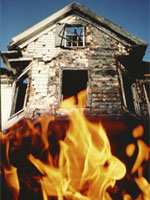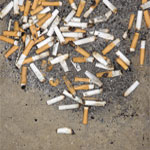Risk of Fire
 Landlords universally recognize the liabilities and hazards of having an indoor smoker as a resident. “I’ve had two places burn down because of cigarettes,” noted one landlord.
Landlords universally recognize the liabilities and hazards of having an indoor smoker as a resident. “I’ve had two places burn down because of cigarettes,” noted one landlord.
The number one cause of fire fatalities in Maryland is cigarette-related fires.
In 2007, careless smoking caused more fire deaths than fires resulting from all other causes. Fourteen cigarette-related fires claimed 25 fire victims, ranging in age from 2 years old to 28 years old. All 14 fires occurred in residential structures.
In Maryland, the fatality rate due to smoking is much higher than the national average – in 2007, cigarette-related fires caused 27% of all fire deaths in Maryland. Nationally, in 2002, only 4% of all residential fires were caused by smoking materials, but these fires are responsible for a disproportionate number of deaths (19%) and injuries (9%). The fatality rate due to smoking is nearly four times higher than the overall residential fire rate; injuries are more than twice as likely.
Maintenance Savings
 Landlords experience a major problem with indoor smoking – the expense in time and materials to repair, refurbish, and otherwise clean up after tenants have smoked consistently in a rental unit. Smell, stains on walls, burns in carpets and countertops, and more smell. In addition to the smell and stains, there is permanent damage caused by careless stubbing out of butts and cigarettes left burning.
Landlords experience a major problem with indoor smoking – the expense in time and materials to repair, refurbish, and otherwise clean up after tenants have smoked consistently in a rental unit. Smell, stains on walls, burns in carpets and countertops, and more smell. In addition to the smell and stains, there is permanent damage caused by careless stubbing out of butts and cigarettes left burning.
Landlords reported that preparing a unit for a new lessee can cost up to or more than double the amount when the previous tenant is an indoor smoker as compared to a non-smoker. In 2004-2005, the Sanford Housing Authority reported that on average, it cost $550 to prepare a nonsmoking unit for a new lessee compared to $1,070 – $1,670 to prepare a unit occupied by a smoker (statistics vary greatly according to the area of carpet, the amount of damage, etc.).
- “We had a chain-smoking resident and when they left it cost us $7,000 to rehab the unit and get out the odor. Then we just said, ‘no more.’”
- “The smoke permeates the walls and the drapes and it’s very difficult to get the odor out without fumigating.”
- “The windows are dripping with yellow, it’s disgusting.”
- “The smell is so hard to get out, we have to use vanilla-scented paint.”
- “Even if you use primer-sealer, it can still bleed through. We’ve used an ozone machine, the whole bit; it stays there. I’ve had to do four coats of primer.”
- “You find cigarette burns in the carpet, the vinyl, the countertops. It does a lot of damage.”
- “We found butts everywhere, burns all over the carpet. It was horrible.”
- “We evicted some chain smokers and it cost us $13,000 to redo everything, from the ceilings to the electrical outlets. I think even the light bulbs smelled.”
Improved Resale Opportunities
Recent research suggests that smoke-free apartment buildings may have increased re-sale value, should you ever decide to sell your building. Agents who have assisted people selling or shopping for everything from starter-home Capes to Victorian mansions, agree: as the number of public places in which a person can smoke has shrunk, so has the number of home buyers who are even willing to consider a house occupied by indoor smokers . (New York Times, “Real Estate & Secondhand Smoke: On Tobacco Road, It’s a Tougher Sell,” February 8, 2004.)
Along with significant risks of property damage in a building without a smoke-free policy, you are also vulnerable to lawsuits by nonsmoking tenants suffering from the effects of secondhand smoke.
- “We had one unit where we had to replace the carpets in four months due to smoking. There were burns, overflowing ashtrays all over. At that point we decided it was best for us and our expenses, and for the tenants themselves, to be in non-smoking units.”
- “We had a lady on an oxygen tank who smoked nonstop. When she finally left to go to a hospice, there were smoke burns everywhere. We were amazed the unit hadn’t burned down.”
- “The places where pictures had been were a white square and everything else was yellow. That was the defining moment where we said it’s time to make a change.”
